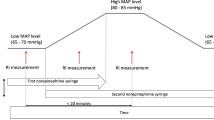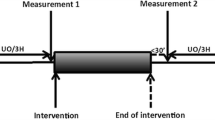Abstract
Objective
To determine the effects of increasing mean arterial pressure (MAP) on renal resistances assessed by Doppler ultrasonography in septic shock.
Design and setting
Prospective, single-center, nonrandomized, open-label trial in the surgical intensive care unit in a university teaching hospital.
Patients and participants
11 patients with septic shock who required fluid resuscitation and norepinephrine to increase and maintain MAP at or above 65 mmHg.
Interventions
Norepinephrine was titrated in 11 patients in septic shock during three consecutive not randomized periods of 2 h to achieve a MAP at successively 65, 75, and 85 mmHg.
Measurements and results
At the end of each period hemodynamic parameters and renal function variables (urinary output, creatinine, clearance) were measured, and Doppler ultrasonography was performed on interlobar arteries to assess the renal resistive index. When increasing MAP from 65 to 75 mmHg, urinary output increased significantly from 76 ± 64 to 93 ± 68 ml/h and the resistive index significantly decreased from 0.75 ± 0.07 to 0.71 ± 0.06. No difference was found between 75 and 85 mmHg.
Conclusions
Doppler ultrasonography and resistive index measurements may help determine in each patient the optimal MAP for renal blood flow and may be a relevant end-point to titrate the hemodynamic treatment in septic shock.



Similar content being viewed by others
References
Dellinger RP, Carlet JM, Masur H, Gerlach H, Calandra T, Cohen J, Gea-Banacloche J, Keh D, Marshall JC, Parker MM, Ramsay G, Zimmerman JL, Vincent JL, Levy MM (2004) Surviving Sepsis Campaign guidelines for management of severe sepsis and septic shock. Crit Care Med 32:858–873
Andrews P, Azoulay E, Antonelli M, Brochard L, Brun-Buisson C, Dobb G, Fagon JY, Gerlach H, Groeneveld J, Mancebo J, Metnitz P, Nava S, Pugin J, Pinsky M, Radermacher P, Richard C, Tasker R, Vallet B (2005) Year in review in intensive care medicine, 2004. II. Brain injury, hemodynamic monitoring and treatment, pulmonary embolism, gastrointestinal tract, and renal failure. Intensive Care Med 31:177–188
LeDoux D, Astiz ME, Carpati CM, Rackow EC (2000) Effects of perfusion pressure on tissue perfusion in septic shock. Crit Care Med 28:2729–2732
Bourgoin A, Leone M, Delmas A, Garnier F, Albanese J, Martin C (2005) Increasing mean arterial pressure in patients with septic shock: effects on oxygen variables and renal function. Crit Care Med 33:780–786
Lerolle N, Guerot E, Faisy C, Bornstain C, Diehl JL, Fagon JY (2006) Renal failure in septic shock: predictive value of Doppler-based renal arterial resistive index. Intensive Care Med 32:1553–1559
Radermacher J, Mengel M, Ellis S, Stuht S, Hiss M, Schwarz A, Eisenberger U, Burg M, Luft FC, Gwinner W, Haller H (2003) The renal arterial resistance index and renal allograft survival. N Engl J Med 349:115–124
Bone RC, Balk RA, Cerra FB, Dellinger RP, Fein AM, Knaus WA, Schein RM, Sibbald WJ (1992) Definitions for sepsis and organ failure and guidelines for the use of innovative therapies in sepsis. The ACCP/SCCM Consensus Conference Committee. American College of Chest Physicians/Society of Critical Care Medicine. Chest 101:1644–1655
Garner JS, Jarvis WR, Emori TG, Horan TC, Hughes JM (1988) CDC definitions for nosocomial infections, 1988. Am J Infect Control 16:128–140
Michard F, Chemla D, Richard C, Wysocki M, Pinsky MR, Lecarpentier Y, Teboul JL (1999) Clinical use of respiratory changes in arterial pulse pressure to monitor the hemodynamic effects of PEEP. Am J Respir Crit Care Med 159:935–939
Michard F, Boussat S, Chemla D, Anguel N, Mercat A, Lecarpentier Y, Richard C, Pinsky MR, Teboul JL (2000) Relation between respiratory changes in arterial pulse pressure and fluid responsiveness in septic patients with acute circulatory failure. Am J Respir Crit Care Med 162:134–138
Mostbeck GH, Zontsich T, Turetschek K (2001) Ultrasound of the kidney: obstruction and medical diseases. Eur Radiol 11:1878–1889
Tublin ME, Bude RO, Platt JF (2003) The resistive index in renal Doppler sonography: where do we stand? AJR Am J Roentgenol 180:885–892
Pourcelot L (1974) Applications cliniques de l'examen Doppler transcutané. In: Peronneau P (ed) Velocimetrie ultrasonore Doppler, INSERM, Paris, pp 213–240
Knapp R, Plotzeneder A, Frauscher F, Helweg G, Judmaier W, zur Nedden D, Recheis W, Bartsch G (1995) Variability of Doppler parameters in the healthy kidney: an anatomic-physiologic correlation. J Ultrasound Med 14:427–429
Platt JF, Ellis JH, Rubin JM (1991) Examination of native kidneys with duplex Doppler ultrasound. Semin Ultrasound CT MR 12:308–318
Platt JF (1992) Duplex Doppler evaluation of native kidney dysfunction: obstructive and nonobstructive disease. AJR Am J Roentgenol 158:1035–1042
Rawashdeh YF, Djurhuus JC, Mortensen J, Horlyck A, Frokiaer J (2001) The intrarenal resistive index as a pathophysiological marker of obstructive uropathy. J Urol 165:1397–1404
Shokeir AA, Abubieh EA, Dawaba M, el-Azab M (2003) Resistive index of the solitary kidney: a clinical study of normal values. J Urol 170:377–379
Ohta Y, Fujii K, Arima H, Matsumura K, Tsuchihashi T, Tokumoto M, Tsuruya K, Kanai H, Iwase M, Hirakata H, Iida M (2005) Increased renal resistive index in atherosclerosis and diabetic nephropathy assessed by Doppler sonography. J Hypertens 23:1905–1911
Petersen LJ, Petersen JR, Ladefoged SD, Mehlsen J, Jensen HA (1995) The pulsatility index and the resistive index in renal arteries in patients with hypertension and chronic renal failure. Nephrol Dial Transplant 10:2060–2064
Radermacher J, Ellis S, Haller H (2002) Renal resistance index and progression of renal disease. Hypertension 39:699–703
Schrier RW, Wang W (2004) Acute renal failure and sepsis. N Engl J Med 351:159–169
Bellomo R, Giantomasso DD (2001) Noradrenaline and the kidney: friends or foes? Crit Care 5:294–298
Reisbeck M, Astiz ME (2005) Arterial pressure, vasopressors and septic shock: higher is not necessarily better. Crit Care Med 33:906–907
Peng ZY, Critchley LA, Fok BS (2005) The effects of increasing doses of noradrenaline on systemic and renal circulations in acute bacteraemic dogs. Intensive Care Med 31:1558–1563
Zubarev AV (2001) Ultrasound of renal vessels. Eur Radiol 11:1902–1915
Derchi LE, Leoncini G, Parodi D, Viazzi F, Martinoli C, Ratto E, Vettoretti S, Vaccaro V, Falqui V, Tomolillo C, Deferrari G, Pontremoli R (2005) Mild renal dysfunction and renal vascular resistance in primary hypertension. Am J Hypertens 18:966–971
Cherry RA, Eachempati SR, Hydo L, Barie PS (2002) Accuracy of short-duration creatinine clearance determinations in predicting 24-hour creatinine clearance in critically ill and injured patients. J Trauma 53:267–271
Author information
Authors and Affiliations
Corresponding author
Rights and permissions
About this article
Cite this article
Deruddre, S., Cheisson, G., Mazoit, JX. et al. Renal arterial resistance in septic shock: effects of increasing mean arterial pressure with norepinephrine on the renal resistive index assessed with Doppler ultrasonography. Intensive Care Med 33, 1557–1562 (2007). https://doi.org/10.1007/s00134-007-0665-4
Received:
Accepted:
Published:
Issue Date:
DOI: https://doi.org/10.1007/s00134-007-0665-4




